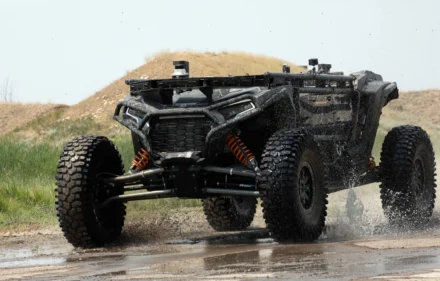LAS VEGAS (AFNS) —
The Department of the Air Force took a bold step toward future command and control capabilities with the successful completion of its first Decision Advantage Sprint for Human-Machine Teaming, or DASH, experiment, recently held at the Howard Hughes Operations Center, or H2O, in Las Vegas, Nevada.

“The DASH experiment showed how machine support can dramatically reduce decision time and improve decision quality for air battle managers working in complex operational environments,” said Col. Christopher Cannon, Advanced Battle Management Cross-Functional Team lead. “Battle management teams were exercising command and control decision advantage.”
This two-week event brought together operational U.S. and Canadian warfighters, industry and Shadow Operations Center-Nellis software developers, to prototype microservices aimed at accelerating and improving decision-making in high-tempo battle management scenarios framed by the Transformational Model for Decision Advantage developed by the ABMS CFT.
“To deliver meaningful capability to the joint force, we must co-develop with industry partners who can iterate rapidly and help us operationalize software to meet urgent warfighter needs for today’s challenges and tomorrow’s fights. DASH experiments accelerate delivery of C2 and intelligence microservices that go beyond user interfaces and dashboards to directly address the (Combined Joint All-Domain Command and Control) imperative for decision advantage,” said Col. Jonathan Zall, ABMS Capability Integration chief.
Led by the ABMS CFT in partnership with the 711th Human Performance Wing, the Air Force Research Laboratory, the Integrated Capabilities Command and the 805th Combat Training Squadron, also known as the ShOC-N, the event focused on a critical subfunction of the Transformational Model – Battle Management: Perceive Actionable Entity.
“This is not just about accelerating data,” Cannon said. “It’s about accelerating decisions. DASH lets us move beyond buzzwords and into real-world prototyping, software built around the actual decisions our warfighters must make under pressure.”
The Transformational Model – Battle Management: Perceive Actionable Entity function determines which actions are possible, permissible and desirable against an operational entity, from targeting to rescue to resupply. Four selected industry teams and a ShOC-N coding team partnered with Total Force and Royal Canadian Air Force air battle managers in a simulated, high-pressure combat environment, building and testing code designed to help warfighters make faster and more effective decisions.
“Our C2 systems are still putting the burden of complex decision-making entirely on the human; this sprint starts to change that by giving our Airmen digital teammates that help them perceive, decide and act faster,” said Lt. Col. Shawn Finney, 805th CTS/ShOC-N commander, Nellis Air Force Base, Nevada. “The ShOC’s H2O center serves as an unclassified software development and vendor engagement hub allowing the DASH teams to rapidly code.”
From concept to capability: DASH in action
DASH participants were challenged to develop working software that output “Battle Effects,” battlefield-changing recommendations bounded by operational constraints like rules of engagement and time sensitivity. The tools were not pre-prescribed in format or interface, allowing developers flexibility in how their software performed decision-making and delivered information.
“What set the DASH experiment apart was its deliberate depth, driven by a focus on the end-user’s specific challenge. Instead of a generalized showcase, concentrating intensely on the PAE function allowed a rigorous evaluation of how advanced tools integrate into the operator’s critical workflow. This targeted, user-centric approach is key to genuinely operationalize agentic AI where it matters most, yielding concrete insights for the warfighter,” said an industry participant.
To measure the impact of human-machine teaming, the experiment was conducted in two phases. First, battle managers executed a combat scenario using only their existing tools and training—without any machine assistance. This established a performance baseline. In the second phase, they faced similar but not identical scenarios, this time with prototype decision-support tools developed during the sprint. By comparing performance across both scenarios, the assessment team measured how much the software improved decision speed and accuracy.
“The DASH experiment isn’t just a coding sprint—it’s a learning environment. Industry teams bring diverse perspectives and technical approaches that push us to think differently about C2. That collaboration accelerates our ability to deliver functional software and refine requirements for the entire enterprise,” said Lt. Col. Wesley Schultz, 805th CTS/ShOC-N director of operations.
The TM-BM DASH approach allowed for rapid development of machine teammates with clear, testable goals.
“DASH is the start of a new model for C2 software acquisition — one that begins with the decision, not the platform,” Cannon said. “We’re not buying software to display more data. Coders are building software that actively helps operators transform that data into measurably better battle management.”
Battle managers participating in the experiment responded positively, with anecdotal evidence suggesting the tools helped them process information more effectively and improve confidence in their decisions. Importantly, the tools required minimal training, reflecting the DASH experiment’s emphasis on lightweight, adaptable integration. Operators engaged directly with developers to refine the tools in real time, offering interface feedback that improved usability during the sprint itself.
“It was an incredible opportunity to be part of the inaugural DASH human-machine interface effort in battle management. I’m always looking for new ways to help make our force more expeditionary, more precise, and ultimately, more lethal,” said 1st Lt. Bennie Crawford, Georgia Air National Guard, 116th Air Control Wing, Robins AFB, Georgia.
ShOC-N: The engine behind DASH
The ShOC-N staff and facility played a critical role in the DASH by crafting the combat-representative scenario, using modeling and simulation technology presenting this simulated battlespace using an unclassified environment, reducing the barrier to entry for industry.
“At ShOC-N, we don’t just simulate conflict, we simulate decision pressure. The DASH experiment gave us a chance to immerse software developers in the reality our warfighters face, so the tools they build are operational from day one,” Finney said.
ShOC faculty also provided operator instruction and facilitated final outbriefs to senior stakeholders from Advanced Battle Management System Cross-Functional Team, Air Force Research Laboratory, Integrated Capabilities Command and 711th HPW.
“Our initial analysis illustrates that when the software developers’ tools were applied, not only did the human-machine team’s average decision-making time decrease seven-fold, but software ‘machines’ responded to more than twice as many dilemmas as the humans alone, and microservices generated three times the number of valid solutions, what we call ‘Battle Effects’,” Cannon said. “Machine answer errors were on par with human error, not bad for a week’s worth of coding. We demonstrated that machines absolutely helped, software services helped, but we also demonstrated that we can in fact build a software microservice that allows this to happen and gives us a more capable human-machine team.”
Each DASH enriches valuable software requirements that will find their way into future C2 requirements and gives participating industry early insight and practice in crafting their answers to those requirements. The experiment validated a repeatable, scalable methodology: design, develop, deploy and evaluate. This approach will guide future sprints across a growing catalog of decision functions. All findings, including technical and functional requirements, will inform future C2 software strategies and investments across the DAF’s C2 enterprise.
Beyond the sprint: The future of human-machine teaming
The DASH experiments translate abstract concepts like “decision advantage” into tangible, testable software capabilities. It marks a shift in Air Force capability development culture, developing functional and technical requirements alongside warfighters, with code in hand.
“Decision advantage is the capability gap that underwrites all others,” Finney said. “With DASH, we’re not just closing that gap, we’re coding directly into it.”
The ABMS CFT, in partnership with the 711th HPW, AFRL Information Directorate, ICC, and the 805th Combat Training Squadron, will host two additional DASH events later this year, each focusing on a different decision function within the TM-BM model.
“This is where theory meets execution,” Zall said. “We’ve spent years defining what decision advantage looks like. DASH is about delivering it by building software that helps our operators act faster and smarter than our adversaries. As the Air Force continues to iterate, experiment and evolve, the human-machine team will remain at the heart of the Department’s push for decision advantage.”
By Deb Henley
505th Command and Control Wing Public Affairs



























































































































